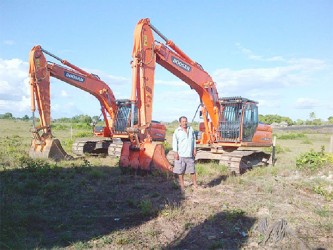Two excavators which were linked to furtive plans for a road in a remote part of Region Nine and possibly mining in the New River Triangle were on Sunday removed from the Rupununi village of Karaudarnau after being abandoned there for over three months.
One was placed on a low-bed truck and said to be returning to Lethem. The other was driven on the trail heading in the direction of Aishalton, a councillor of the Region Nine Amerindian community said on Sunday. Stabroek News was told that Brazilian contractor Junior Martin returned to the community about three weeks ago and told the toshao, Valare Anderson that he would be sending persons to pick up the machines. The community’s leader was reportedly compensated for keeping the machines safely in his yard and Martin reportedly also promised to get some furniture for the school.

Observers had said that Martin should have been questioned by the authorities over who had authorised the road works through Parabara and for what purpose.
Anderson had recently returned to the village after visiting Georgetown where he met officials of the Ministry of Natural Resources and the Environment and asked about the excavators and the building of a road to Parabara. According to a resident, he told villagers that he got no clear answers and officials pointed fingers at one another. Stabroek News was unable to contact Anderson on Sunday.
Revelations of a proposed new road to Parabara prompted concerns and led to further revelations of planned prospecting in the New River Triangle, which was later aborted under pressure over the manner in which the permission was granted.
Though there have been denials that there is a link between the two operations, observers had said it appeared that the intention to build the road towards the New River in south-east Guyana was part of the planning for a prospecting licence to be issued to Muri Brasil Ventures Inc (MBVI).
The disquiet over the now-aborted road being constructed though the remote community of Parabara led to a disclosure by Minister of Natural Resources Robert Persaud of the survey permission to MBVI.
That disclosure was made to the Guyana Human Rights Association (GHRA), which had raised public concerns about the Parabara road. In a meeting, the GHRA was assured by the minister that there was no mining related road construction in the New River Triangle and that the Permission for Geological and Geophysi-cal Surveys (PGGS) would not lead to prospecting there. Documents subsequently leaked to Stabroek News showed that a maximum of eighteen prospecting licences in the New River Triangle for rare earth metals and other minerals were inevitable under the PGGS if applied for.
Persaud and the government came under pressure to explain when a decision was taken to open up the New River to mining along with a host of other questions. Persaud was also accused by the GHRA and the Natural Resources Committee of Parliament of misleading them on the matter of MBVI. MBVI subsequently pulled out of the venture.
The Karaudarnau Village Council had stopped the excavators from proceeding after learning of their intentions in relation to the Parabara road. The operators had not sought the permission of the council as is required. Martin subsequently told village leaders that he was going to get the permission of the authorities.
“It will affect my people, resources, animals, trees…” Anderson had told Stabroek News, in explaining why he stopped the excavators from proceeding to build the road which would also run through the village.
At an emergency village meeting, the majority of the villagers were against the building of the new road.
Anderson and a senior village councillor in an interview with Stabroek News had emphasized that the majority of the community is against the building of the road as it would impact their resources.
It was pointed out that there is already a road to Parabara and they would favour the upgrading of this road rather than a new road. In the light of the Low Carbon Development Strategy (LCDS), Anderson said, it is inexplicable why the authorities would want to encourage further deforestation. Asked whether the Minis-try of Natural Resources and the Environment had contacted him during an investigation that the ministry had done on the Parabara road, he said that no representative had contacted him.
The ministry in the report had only referred to the existing road. The ministry had told the GHRA that machinery had been assembled for road construction but work had not yet begun.
The ministry had further told the GHRA that the Toshao of Masekenari, a community a great distance away, had been written to advising that “the ministry has not granted permission or awarded any licence for mining operations in the area. As such, there should be no road construction taking place in the area as an aspect of mining operations.” It was not clear why the letter was not addressed to the leader of Parabara.
The leaders were strongly against the building of the new road and said that even if the authorities gave permission, they are against the new road through the village land. “The village council say we don’t want our natural resources to be destroyed by another road… we want to protect the land,” Anderson had said. “They will damage the trees, push them down without using them.”




